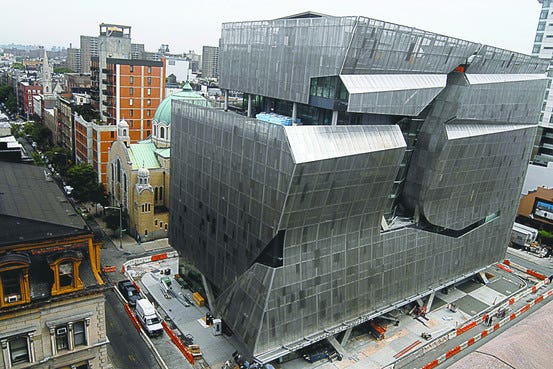
Clem Labine
Buildings That Eat Their Owners
The lunacy that causes cultural institutions to build ever-more-bizarre – and expensive – “iconic” buildings has claimed another victim. Cooper Union in New York City has, for 155 years, not charged tuition for its highly regarded courses in art, architecture and engineering. But that all changes next year – due in large part to the $175-million mortgage the trustees took out to build a ludicrous new engineering building by starchitect Thom Mayne. Students will now need to pony up around $20,000 per year to cover the mortgage and other costs – thereby demolishing the legacy of visionary founder Peter Cooper.
This disaster results from Cooper Union’s trustees being seduced by the siren song of celebrity architecture. The trustees naively believed their fund-raising problems would be solved if they created a “naming opportunity” by constructing a signature building designed by a brand-name architect. The trustees were sure a deep-pocketed donor would come along, anxious to get his or her name affixed to a trophy building. The trustees were wrong; no mega-rich donor materialized. And now the students will pay the price for the trustees’ gullibility.
Of course, Cooper Union is not the first institution to be devastated by pricey starchitecture. The American Center in Paris was an early casualty. The Folk Art Museum in New York is a more recent instance. The museum floated a $32-million bond issue so architects Tod Williams and Billie Tsien could design a trendy new building on Manhattan’s 57thStreet.
The Museum eventually defaulted on its bonds and had to sell the building to the Museum of Modern Art (which wants the land, not the building). The Folk Art Museum is now reduced to a shadow of its former self in much smaller rented quarters, while the Museum of Modern Art hopes to raze the ill-fated structure – despite howls of protest from fans of Modernism.
Firmitas, Utilitas et Venustas
The agony of these institutions – and others like them – stems from becoming mesmerized by the "Bilbao Effect.” They chose to ignore Vitruvius’s admonition that a building should embody firmitas, utilitas, venustas; that is, a building should be solidly constructed, appropriate to its function (including the budget) and good-looking. Instead, many of today’s cultural clients look primarily for novelty and provocation.
Unfortunately, when you design a one-off sculpture-building that’s never been seen before, all details have to be devised from scratch. This is both expensive and error prone. Even when clients are rich enough to survive cost overruns, they are often soon confronted with costly surprise repairs.
American taxpayers just discovered this unpleasant fact when Congress was asked to fork over $85 million to re-install the marble veneer panels on the East Wing of the National Gallery of Art in Washington, D.C. The I.M. Pei building consists of complex interlocking shapes and planes. To give the large planar surfaces a smooth unbroken look, the architect devised what he termed a “breakthrough technology” to attach marble veneer panels to the structural core. The innovative system failed, however, and every single veneer panel is being removed from the building and re-attached.
In the meantime, while these expensive and unexpected repairs are being made to the East Wing, which is always lavishly praised by architecture critics, the gallery’s original West Wing sits next door in quiet dignity. The West Wing by John Russell Pope is also sheathed in marble veneer panels – attached using traditional construction methods. Though 37 years older, the West Wing has never needed the extensive repairs its younger sibling is undergoing.
Let’s hope these expensive disasters will inspire clients to pay more attention to the eternal relevance of Vitruvius’s advice: firmitas, utilitas, venustas.
Clem Labine is the founder of Old-House Journal, Clem Labine’s Traditional Building, and Clem Labine’s Period Homes. His interest in preservation stemmed from his purchase and restoration of an 1883 brownstone in the Park Slope section of Brooklyn, NY.
Labine has received numerous awards, including awards from The Preservation League of New York State, the Arthur Ross Award from Classical America and The Harley J. McKee Award from the Association for Preservation Technology (APT). He has also received awards from such organizations as The National Trust for Historic Preservation, The Victorian Society, New York State Historic Preservation Office, The Brooklyn Brownstone Conference, The Municipal Art Society, and the Historic House Association. He was a founding board member of the Institute of Classical Architecture and served in an active capacity on the board until 2005, when he moved to board emeritus status. A chemical engineer from Yale, Labine held a variety of editorial and marketing positions at McGraw-Hill before leaving in 1972 to pursue his interest in preservation.








